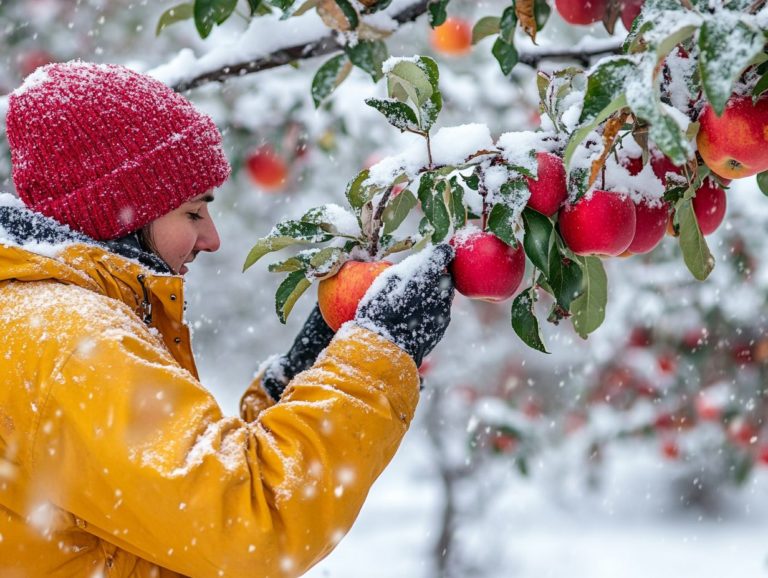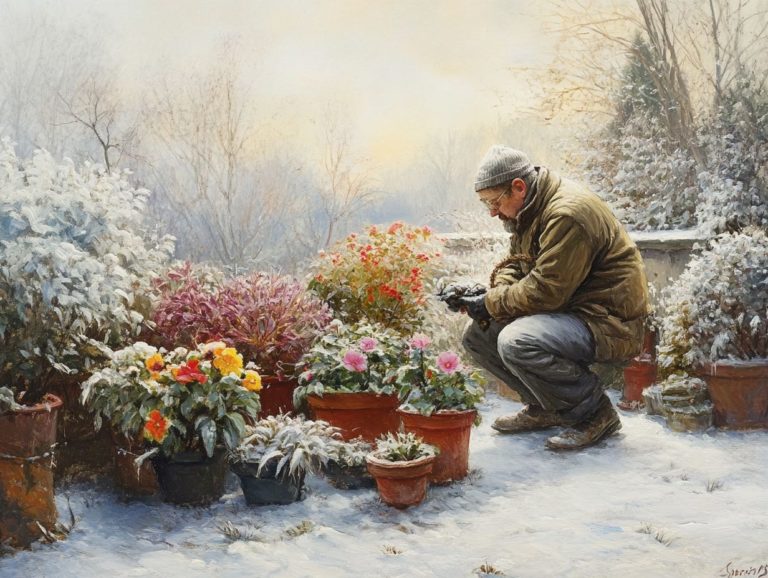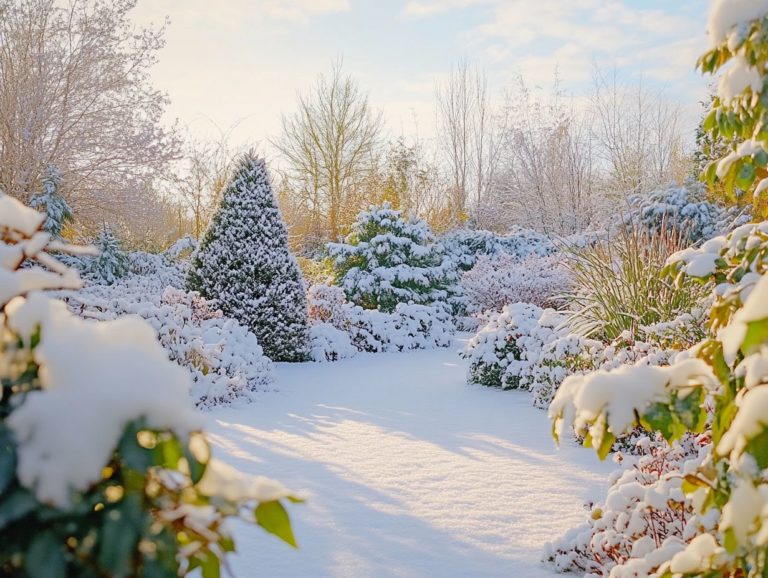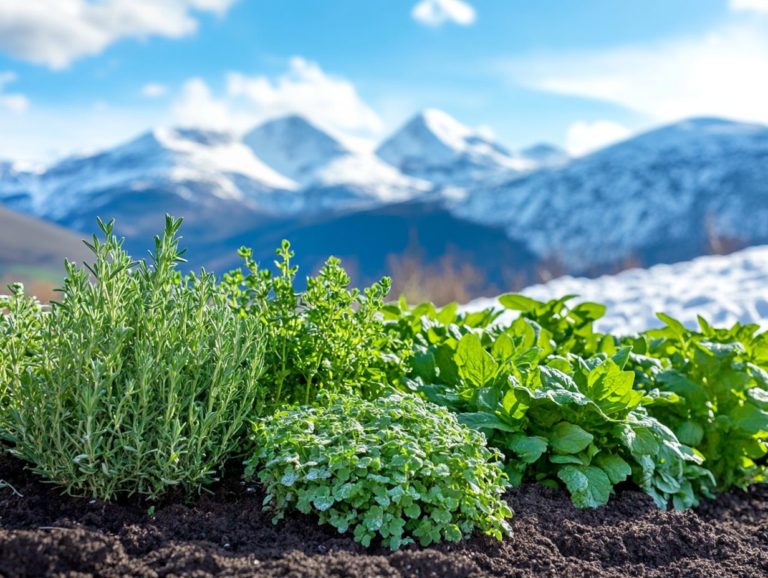Best Cold-Climate Plants for Xeriscaping
Are you ready to craft a stunning, water-efficient landscape that flourishes in cold climates? Look no further than xeriscaping, the ideal solution that lets you revel in a beautiful garden while conserving water and minimizing maintenance.
This article delves into the principles and advantages of cold-climate xeriscaping, guiding you in selecting the best plants for your region. You ll discover design tips, soil options, and strategies for incorporating hardscaping elements seamlessly into your landscape.
Jump at the chance to turn your outdoor space into a stunning, sustainable oasis!
Contents
- Key Takeaways:
- 1. Understanding Xeriscaping and Its Benefits
- 2. Factors to Consider When Choosing Cold-Climate Plants for Xeriscaping
- 3. Best Cold-Climate Plants for Xeriscaping
- 4. Native Plants vs. Non-Native Plants for Xeriscaping
- 5. Tips for Maintaining Cold-Climate Xeriscapes
- 6. Creating a Xeriscape Design with Cold-Climate Plants
- 7. How Xeriscaping Can Help Conserve Water in Cold Climates
- 8. Incorporating Hardscaping into a Cold-Climate Xeriscape
- 9. Common Mistakes to Avoid When Xeriscaping in Cold Climates
- 10. Choosing the Right Soil and Mulch for Cold-Climate Xeriscapes
- 11. Using Drip Irrigation in Cold-Climate Xeriscapes
- 12. Adding Color to Cold-Climate Xeriscapes with Annuals and Perennials
- 13. Incorporating Edible Plants into Cold-Climate Xeriscapes
- 14. Understanding the Importance of Proper Plant Placement in Cold-Climate Xeriscapes
- 15. How to Create a Low-Maintenance Cold-Climate Xeriscape
- Frequently Asked Questions
- What are the best cold-climate plants for xeriscaping?
- Are there any flowering plants that can survive in a cold, dry climate?
- Can succulents be used in xeriscaping for cold climates?
- What are some low-maintenance options for xeriscaping in cold climates?
- Can I still have a lush, green garden with xeriscaping in a cold climate?
- Are there any special considerations for xeriscaping in a cold, snowy climate?
Key Takeaways:
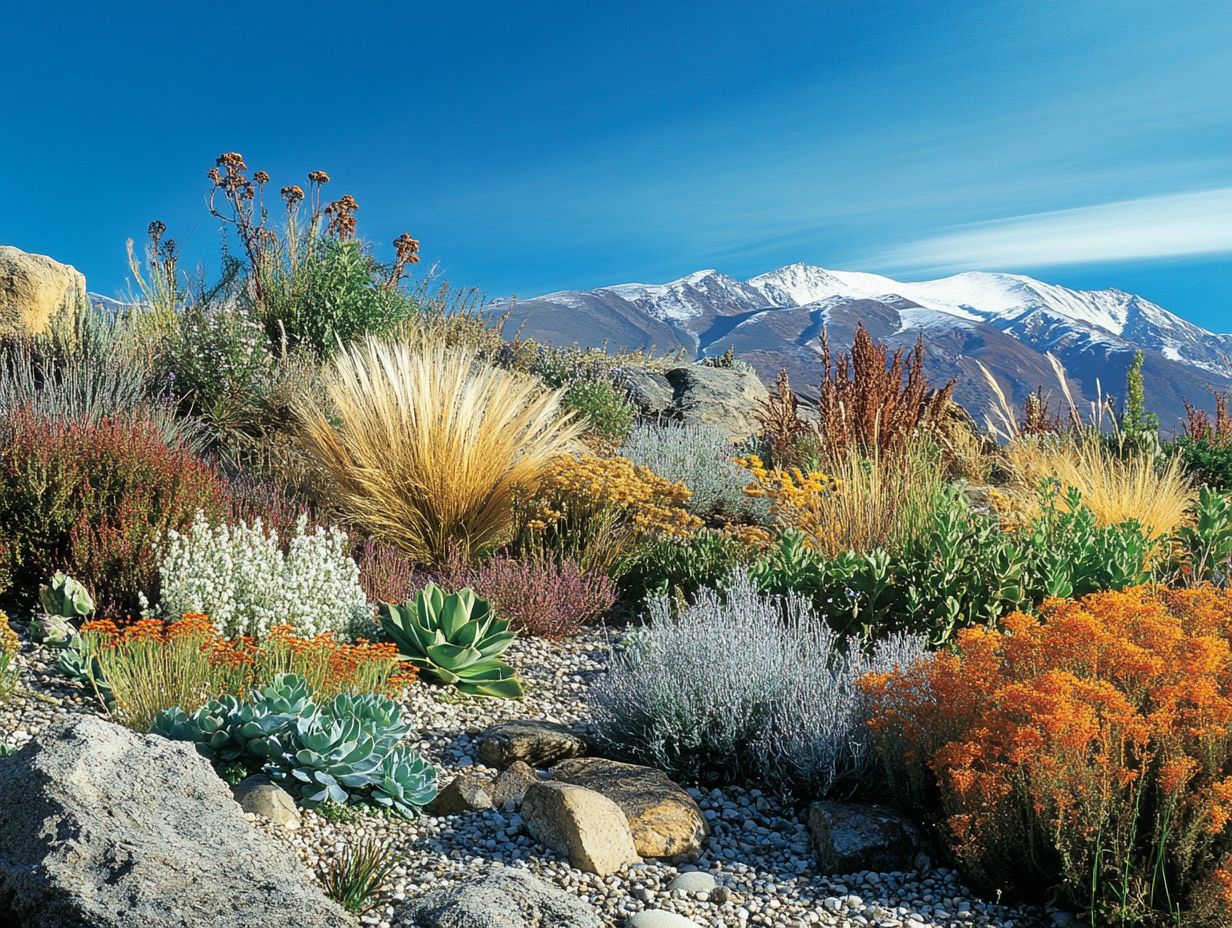
- Choose cold-climate plants that need less water and can withstand freezing temperatures for successful xeriscaping.
- Incorporate native plants in your cold-climate xeriscape for better adaptation to the environment and lower maintenance.
- Proper plant placement, soil, and hardscaping are crucial elements to consider when designing a low-maintenance and water-conserving cold-climate xeriscape.
1. Understanding Xeriscaping and Its Benefits
Xeriscaping is your gateway to sustainable landscaping, beautifully designed to conserve water an absolute must in regions prone to summer droughts, like California and Colorado. By choosing plants that need less water and integrating efficient irrigation systems (methods to supply water to plants), you can significantly reduce water usage while still crafting a stunning garden.
Focusing on native plants enhances biodiversity and establishes vital habitats for local wildlife, promoting ecological balance. When you incorporate efficient irrigation techniques, such as drip systems and mulch, you minimize water waste and ensure your plants receive just the right amount of moisture without any excess runoff.
Embracing sustainable gardening practices like composting and using organic fertilizers enriches the soil while preserving our precious natural resources. Beyond their ecological advantages, xeriscaped gardens offer captivating visual interest and texture through the diverse shapes and colors of drought-resistant flora, including ornamental grasses and flowering plants. This proves that sustainability and beauty can truly coexist in harmony.
2. Factors to Consider When Choosing Cold-Climate Plants for Xeriscaping
When choosing cold-climate plants for xeriscaping, you need to take several factors into account, such as plant hardiness and seasonal needs. Referencing selecting cold-climate plants for urban gardens can help with this careful planning, ensuring successful growth and sustainability in challenging environments.
This is especially important for gardeners like you operating within Zone 5, where winter temperatures can plummet to between -20 F and -10 F. Understanding the specific requirements of this zone allows you to select plants that not only thrive but also endure the climatic hardships.
Soil type plays a crucial role in this endeavor. Whether your soil is sandy, clayey, or loamy, each has its own drainage characteristics that directly influence plant survival. Seasonal changes also affect moisture levels, underlining the necessity for careful planning and mulching to retain moisture during those dry spells.
Ultimately, choosing plants that can adapt to these various factors is essential for your xeriscaping success and effective plant care.
3. Best Cold-Climate Plants for Xeriscaping
The best cold-climate xeriscape plants offer you a wealth of cold-hardy options, including succulents, from native species to ornamental grasses and flowering varieties that thrive with minimal water.
Take Yarrow, for example. Not only is it drought-resistant, but it also attracts beneficial insects making it a standout choice for enhancing biodiversity in your garden. Similarly, Lavender graces you with fragrant blooms and requires little watering once established, all while delivering an eye-catching aesthetic.
Then there’s the Autumn Blaze Maple, celebrated for its brilliant fall colors and its ability to thrive in colder climates. It adds a touch of structural interest to your landscape. By selecting these plants, you’re effectively using scarce water resources, ensuring your xeriscape is both beautiful and sustainable, even in challenging environments.
Now is the time to embark on your xeriscaping journey. Start planning your sustainable garden today!
4. Native Plants vs. Non-Native Plants for Xeriscaping
Choosing native or non-native plants for xeriscaping can be challenging. Consider their unique benefits like drought resistance, habitat conservation, and support for local pollinators.
Native plants, like Allegheny Spurge, thrive in your climate with less upkeep. They adapt to soil conditions and need less water over time.
In contrast, non-native species, such as the Japanese Lilac, may be beautiful but often require more care and resources.
Native plants help nurture biodiversity by providing food and habitat for local wildlife. Non-natives can disrupt ecosystems, outcompeting indigenous flora.
Choosing native plants conserves water and preserves local wildlife. Embrace the beauty of your local environment!
5. Tips for Maintaining Cold-Climate Xeriscapes
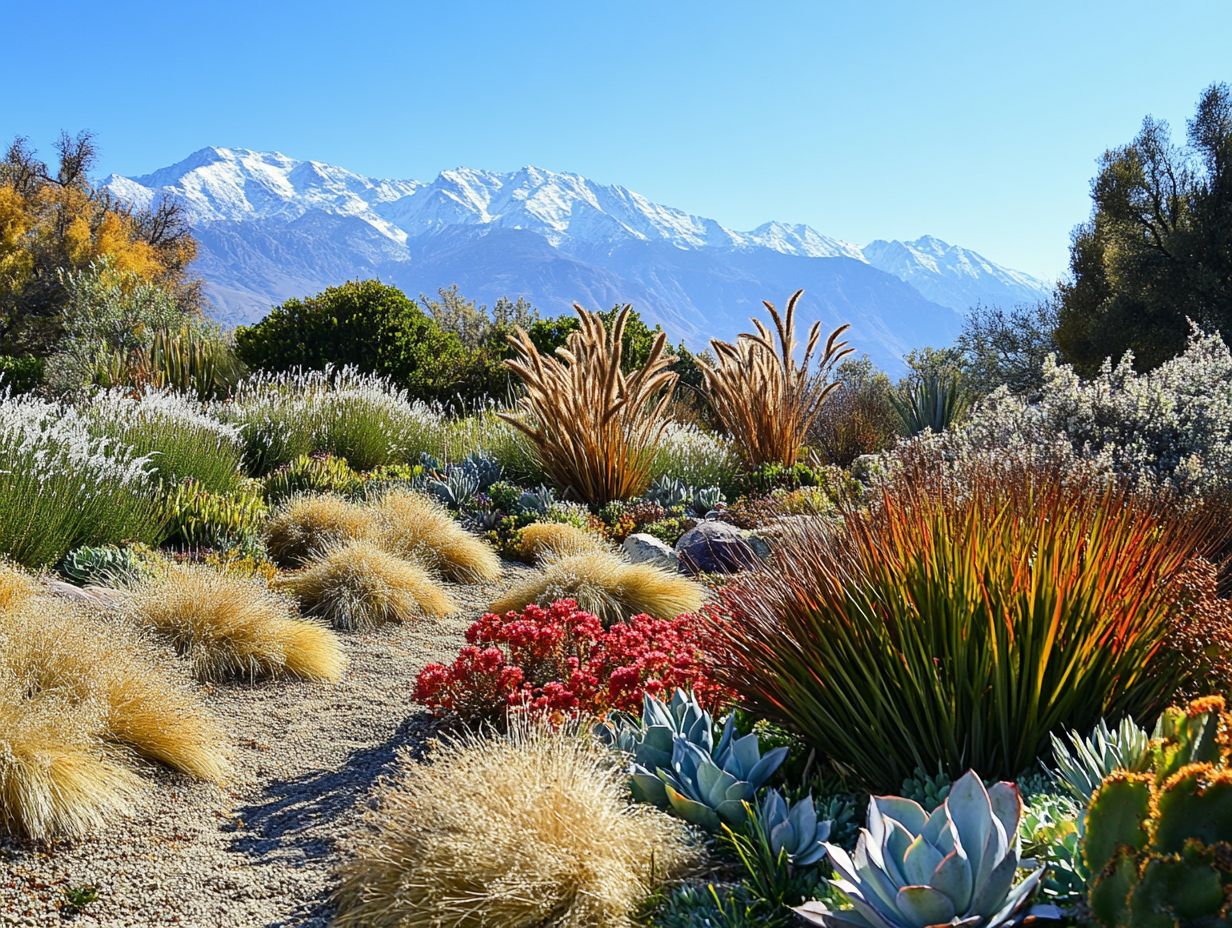
Maintaining a cold-climate xeriscape requires specific strategies. You can enhance your garden by exploring the top 10 low-maintenance plants for cold climates, focusing on effective irrigation methods, thoughtful mulching, and seasonal care to ensure longevity and beauty year-round.
By implementing these techniques, you can create a resilient landscape that conserves water and thrives amidst varying weather conditions. Proper mulching helps retain soil moisture, reduces weeds, and protects plant roots from harsh temperatures.
Utilizing winter gardening techniques, like draping sensitive plants with burlap, can significantly boost survival rates. It s essential to develop an efficient irrigation schedule that aligns with seasonal shifts, maximizing water use while minimizing waste.
Embracing low-maintenance design elements, such as native plants, herbaceous perennials, and hardscaping features, simplifies upkeep and provides a sustainable gardening experience.
6. Creating a Xeriscape Design with Cold-Climate Plants
Designing a xeriscape garden with cold-climate plants requires a careful approach. Focus on hydro zoning, which means grouping plants based on their water needs, and efficient irrigation techniques. For optimal choices, consider the best plants for small cold-climate gardens to enhance water retention and visual appeal through strategic use of ground cover and sustainable landscape practices.
This method conserves water and cultivates an environment that resonates with the natural ecosystem. Thoughtfully arranging plants according to their water requirements ensures each area of your garden receives the right amount of moisture no waste involved.
In colder climates, resilient ground covers like creeping thyme and sedum create a lush carpet across the landscape. They help retain heat and moisture during colder months. This thoughtful layout creates a vibrant xeriscape that thrives with nature.
7. How Xeriscaping Can Help Conserve Water in Cold Climates
Xeriscaping is essential for conserving water in cold climates. It employs water-wise gardening practices that include moisture conservation techniques and sustainable plant choices for cold climates and irrigation systems suitable for Zone 5.
By choosing drought-resistant plants that thrive in lower moisture conditions, you can craft stunning landscapes that demand minimal water. Native species like sedums and ornamental grasses adapt gracefully to cooler temperatures and varying precipitation levels.
Integrating smart irrigation methods, such as drip systems, ensures water reaches the roots directly. This minimizes evaporation and runoff. With the right design, xeriscaping allows for beautiful drought gardens even during dry spells.
Thoughtful choices lead to vibrant, sustainable outdoor spaces, no matter the climate challenges you face. Start planning your xeriscape today! Enjoy a stunning, low-maintenance landscape that saves water.
8. Incorporating Hardscaping into a Cold-Climate Xeriscape
Adding hardscaping elements can transform your cold-climate xeriscape. It provides structure, erosion control, and outdoor living spaces that enhance your garden’s natural beauty.
Using different materials, such as natural stones and pavers, significantly boosts functionality and visual appeal. Natural stones create pathways and patios that blend seamlessly with your xeriscape plants.
Pavers, on the other hand, offer design flexibility. You can create intricate patterns that define zones while ensuring smooth transitions between hard surfaces and flourishing plant life.
This integration minimizes water runoff. Excitingly, it also nurtures the growth of plants that can survive with little water, enriching your overall outdoor experience.
9. Common Mistakes to Avoid When Xeriscaping in Cold Climates
Avoiding common mistakes can elevate your gardening success in cold-climate xeriscaping. Focus on plant selection, soil drainage, and understanding seasonal needs.
As you embark on this journey, choose wisely! Select plants that thrive in colder temperatures and can endure periods of drought.
Pay attention to soil drainage, as bad drainage can cause plants to rot. Consider incorporating raised beds to manage soil quality and moisture retention effectively.
Regularly testing your soil with a pH meter provides valuable insights into nutrient content, allowing you to make necessary adjustments. Don t overlook the power of mulching; it conserves moisture and suppresses weeds, fostering a healthier garden ecosystem.
10. Choosing the Right Soil and Mulch for Cold-Climate Xeriscapes
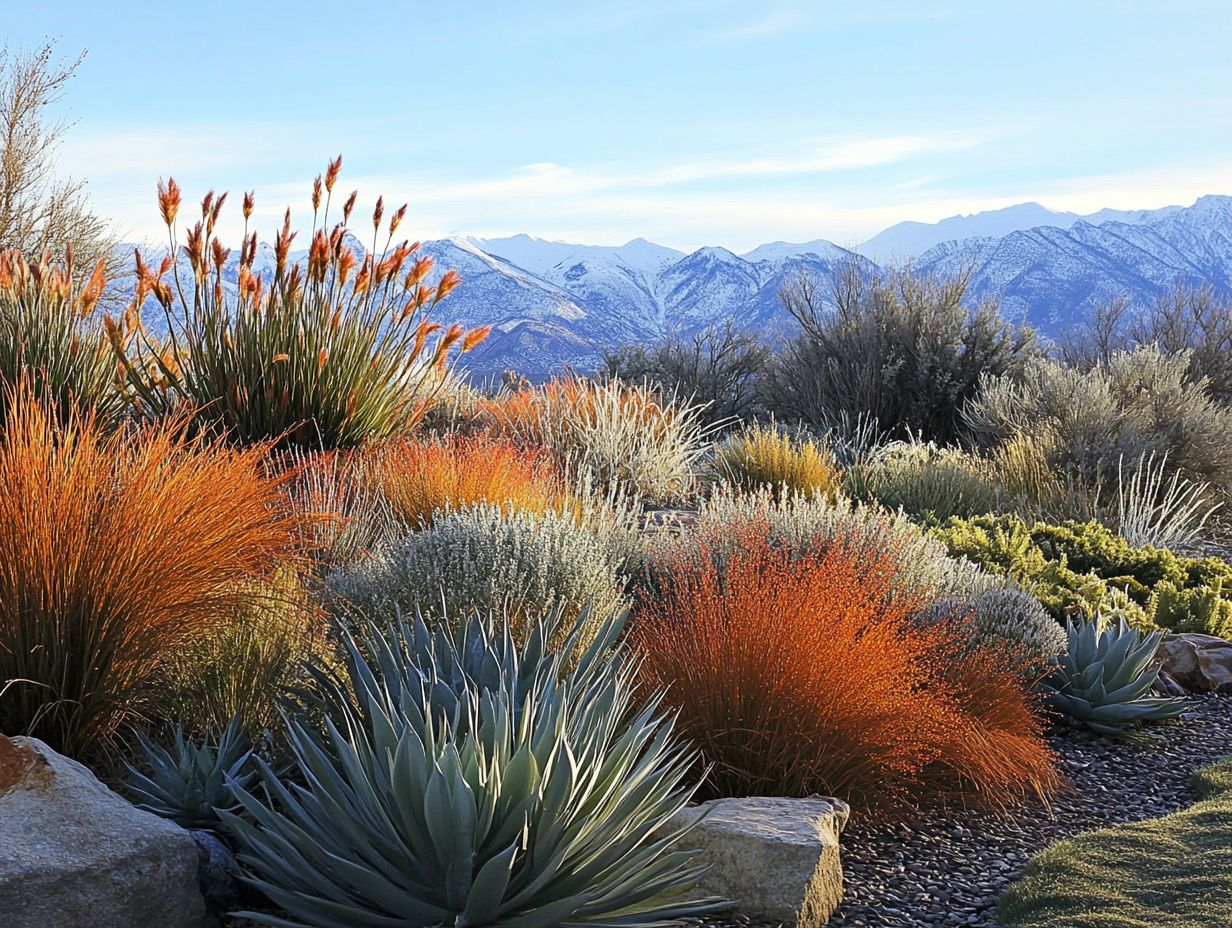
Selecting the right soil and mulch is crucial for mastering cold-climate xeriscapes. These elements profoundly influence moisture conservation, soil drainage, and overall plant health.
Understanding the various soil types sandy, clay, and loamy can impact how well your landscape flourishes. Sandy soil drains quickly but may need more frequent watering, while clay soil retains moisture but can lead to bad drainage and rotting.
Loamy soil, which is a mix of sand, silt, and clay, typically provides the best conditions for plant growth. Mulch also plays a vital role in enhancing these conditions.
In colder climates, options like wood chips, straw, and shredded leaves conserve moisture by reducing evaporation. They also insulate the soil, protecting roots from extreme temperature shifts.
By thoughtfully selecting both soil and mulch, you can cultivate a more resilient and thriving xeriscape.
11. Using Drip Irrigation in Cold-Climate Xeriscapes
Drip irrigation systems offer an exceptional solution for efficiently watering your cold-climate xeriscapes. They help minimize water usage while promoting moisture conservation for various plants.
These innovative systems direct water straight to the roots, enhancing plant health and growth. They significantly reduce evaporation and runoff that often plague traditional methods.
With the ability to adjust flow rates, you can provide precise watering tailored to each plant’s unique needs. This encourages a more sustainable approach to your gardening endeavors.
When installing a drip irrigation system, selecting the right tubing and emitters based on plant requirements is essential. Regularly check for clogs and leaks, and make seasonal adjustments to maintain optimal efficiency.
These best practices ensure your system remains reliable and effective throughout its lifespan.
12. Adding Color to Cold-Climate Xeriscapes with Annuals and Perennials
Incorporating annuals and perennials into your cold-climate water-efficient gardens can significantly elevate the color and floral potential of your landscape. This creates vibrant, sustainable environments that are truly eye-catching.
These plants thrive in cooler temperatures and play a crucial role in supporting local ecosystems. They attract pollinators and provide habitats for beneficial insects. For instance, consider planting:
- Lavender
- Sedum
Both of these beauties bloom from late spring into early summer, adding a delightful array of colors while requiring minimal water. Perennials like coneflower add structure and depth, blooming at various intervals throughout the seasons.
Select these hardy varieties to make your garden vibrant and sustainable! You contribute to sustainable gardening by effectively reducing water usage and fostering resilience in your garden against harsh weather conditions.
13. Incorporating Edible Plants into Cold-Climate Xeriscapes
Integrating edible plants into your cold-climate xeriscapes enhances biodiversity and champions sustainable gardening. You can enjoy fresh produce within a beautifully designed landscape.
This approach allows you to cultivate a delightful array of herbs like rosemary, thyme, and chives, which thrive in drier conditions while infusing your meals with rich flavors. Cold-hardy vegetables such as kale and spinach add vibrant colors and textures to your garden, delivering impressive nutritional benefits.
By carefully selecting these versatile plants, you create a harmonious blend of beauty and functionality. Your outdoor space transforms into both a visual feast and a source of delicious, homegrown food.
This thoughtful integration fosters a deeper connection with nature, providing a truly rewarding experience for anyone fortunate enough to spend time in these meticulously crafted environments.
14. Understanding the Importance of Proper Plant Placement in Cold-Climate Xeriscapes
Proper plant placement is essential in cold-climate xeriscapes, especially when considering the best plants for windy cold-climate gardens. This directly affects your water-wise gardening practices, soil drainage, and each plant’s ability to thrive throughout the seasons.
To effectively evaluate your planting conditions, begin by examining the sunlight exposure in different areas of your garden throughout the day. Note the distinctions between full sun, partial shade, and full shade this will guide your selections.
Assessing soil moisture levels is crucial. Dig into the soil to feel its dampness, helping you determine an appropriate watering schedule. Understand how well your soil drains whether it retains too much water or allows for proper drainage will significantly impact the health and longevity of your plants.
By considering these factors, you can enhance your water conservation efforts while ensuring that each plant flourishes in its optimal environment.
15. How to Create a Low-Maintenance Cold-Climate Xeriscape
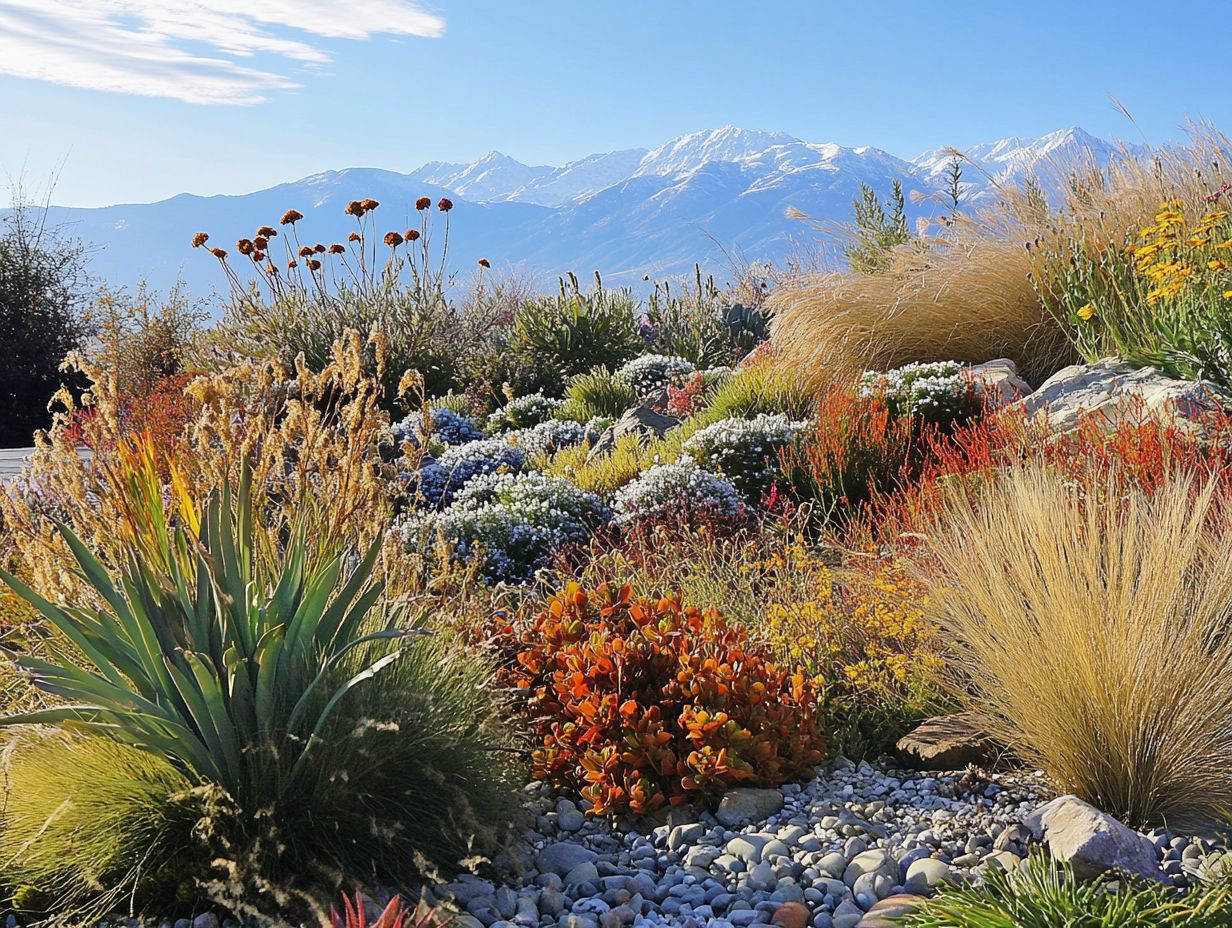
Creating a low-maintenance cold-climate xeriscape requires thoughtful plant selection and strategic design choices. These minimize upkeep while maximizing sustainability and aesthetic appeal.
Choosing hardy plants that thrive in lower temperatures helps you reduce the frequency of replacements. You ensure a resilient landscape throughout the year. Incorporating efficient irrigation systems, like drip irrigation a watering system that delivers water directly to the roots optimizes water use, benefiting both your plants and the environment.
Utilizing mulch around the base of your plants helps retain moisture, suppress weeds, and regulate soil temperature. This significantly cuts down on maintenance tasks. The synergy between these elements fosters a sustainable approach to landscaping.
Imagine stepping into a garden that thrives on little water and bursts with color all year long! Start your own xeriscape project today!
Frequently Asked Questions
What are the best cold-climate plants for xeriscaping?
Some of the best cold-climate plants for xeriscaping include Russian sage, sedum, yarrow, lavender, and thyme. For more information, check out choosing drought-tolerant plants for cold climates. These plants are drought-resistant and can thrive in harsh winter conditions.
Are there any flowering plants that can survive in a cold, dry climate?
Yes! Several flowering plants thrive in cold, dry climates. Consider coneflowers, black-eyed Susans, and butterfly bush. They bring vibrant color and require little care.
Can succulents be used in xeriscaping for cold climates?
Absolutely! Succulents are excellent choices for cold climates. They retain water and withstand extreme weather. Great options include hens and chicks, ice plants, and stonecrop.
What are some low-maintenance options for xeriscaping in cold climates?
Xeriscaping is all about ease! Look for plants like juniper, creeping thyme, and best plants for cold-climate edible landscaping. These require minimal watering and can handle freezing temperatures.
Can I still have a lush, green garden with xeriscaping in a cold climate?
Yes, you can! Xeriscaping doesn t mean you have to give up a lush garden. Add evergreens like spruce and pine to enhance texture and color. Incorporate shrubs like boxwood and holly for a classic touch.
Are there any special considerations for xeriscaping in a cold, snowy climate?
Choose plants that tolerate heavy snow and strong winds. Use rocks or gravel to add texture and prevent erosion. Also, plan for proper drainage to avoid water pooling and freezing.

